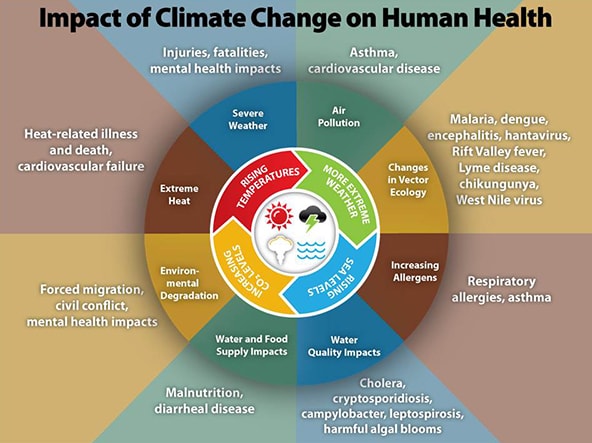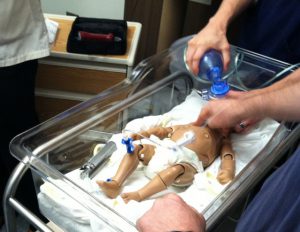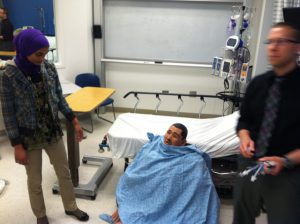Archive for the ‘Global Health’ Category
CDC: Climate Effects on Health
Monday, August 12th, 2019Climate Effects on Health
The information on health effects has been excerpted from the Third National Climate Assessment’s Health Chapterexternal icon. Additional information regarding the health effects of climate change and references to supporting literature can be found in the Health Chapter at http://www.globalchange.gov/engage/activities-products/NCA3/technical-inputsexternal icon.
Climate change, together with other natural and human-made health stressors, influences human health and disease in numerous ways. Some existing health threats will intensify and new health threats will emerge. Not everyone is equally at risk. Important considerations include age, economic resources, and location.
In the U.S., public health can be affected by disruptions of physical, biological, and ecological systems, including disturbances originating here and elsewhere. The health effects of these disruptions include increased respiratory and cardiovascular disease, injuries and premature deaths related to extreme weather events, changes in the prevalence and geographical distribution of food- and water-borne illnesses and other infectious diseases, and threats to mental health.
CDC and APHA Fact Sheets
- Extreme Rainfall and Drought Can Impact our Health pdf icon[PDF – 98 KB]
- Warmer Water and Flooding Increase the Risk of Illness or Injury pdf icon[PDF – 184 KB]
- Climate Change Decreases the Quality of the Air We Breathe pdf icon[PDF 111 KB]
- Extreme Heat Can Impact Our Health in Many Ways pdf icon[PDF – 108 KB]
- Climate Change Increases the Risk of Vector-Borne Diseases pdf icon[PDF – 112 KB]

Which will be the 10 most populous nations by 2100?
Sunday, July 14th, 2019“…..By 2100, new UN figures show that 4 of today’s 10 most populous nations will be replaced by African countries.
Brazil, Bangladesh, Russia and Mexico—where populations are projected to stagnate or decline—will drop out. In their place: Democratic Republic of the Congo, Ethiopia, Tanzania and Egypt. All 4 are projected to more double in population.
Top 10 rankings in population growth by 2100 include only 2 non-African nations—Pakistan and the US.
China will shrink by 374 million fewer people—more than the entire US population……”
Causes of severe pneumonia requiring hospital admission in children around the world
Saturday, June 29th, 2019“…….Between Aug 15, 2011, and Jan 30, 2014, we enrolled 4232 cases and 5119 community controls. The primary analysis group was comprised of 1769 (41·8% of 4232) cases without HIV infection and with positive chest x-rays and 5102 (99·7% of 5119) community controls without HIV infection.
Wheezing was present in 555 (31·7%) of 1752 cases (range by site 10·6–97·3%).
30-day case-fatality ratio was 6·4% (114 of 1769 cases).
Blood cultures were positive in 56 (3·2%) of 1749 cases, and Streptococcus pneumoniae was the most common bacteria isolated (19 [33·9%] of 56). Almost all cases (98·9%) and controls (98·0%) had at least one pathogen detected by PCR in the NP-OP specimen. The detection of respiratory syncytial virus (RSV), parainfluenza virus, human metapneumovirus, influenza virus, S pneumoniae, Haemophilus influenzae type b (Hib), H influenzae non-type b, and Pneumocystis jirovecii in NP-OP specimens was associated with case status.
The aetiology analysis estimated that viruses accounted for 61·4% (95% credible interval [CrI] 57·3–65·6) of causes, whereas bacteria accounted for 27·3% (23·3–31·6) and Mycobacterium tuberculosis for 5·9% (3·9–8·3).
Viruses were less common (54·5%, 95% CrI 47·4–61·5 vs 68·0%, 62·7–72·7) and bacteria more common (33·7%, 27·2–40·8 vs 22·8%, 18·3–27·6) in very severe pneumonia cases than in severe cases.
 RSV had the greatest aetiological fraction (31·1%, 95% CrI 28·4–34·2) of all pathogens. Human rhinovirus, human metapneumovirus A or B, human parainfluenza virus, S pneumoniae, M tuberculosis, and H influenzae each accounted for 5% or more of the aetiological distribution. We observed differences in aetiological fraction by age for Bordetella pertussis, parainfluenza types 1 and 3, parechovirus–enterovirus, P jirovecii, RSV, rhinovirus, Staphylococcus aureus, and S pneumoniae, and differences by severity for RSV, S aureus, S pneumoniae, and parainfluenza type 3. The leading ten pathogens of each site accounted for 79% or more of the site’s aetiological fraction…..”
RSV had the greatest aetiological fraction (31·1%, 95% CrI 28·4–34·2) of all pathogens. Human rhinovirus, human metapneumovirus A or B, human parainfluenza virus, S pneumoniae, M tuberculosis, and H influenzae each accounted for 5% or more of the aetiological distribution. We observed differences in aetiological fraction by age for Bordetella pertussis, parainfluenza types 1 and 3, parechovirus–enterovirus, P jirovecii, RSV, rhinovirus, Staphylococcus aureus, and S pneumoniae, and differences by severity for RSV, S aureus, S pneumoniae, and parainfluenza type 3. The leading ten pathogens of each site accounted for 79% or more of the site’s aetiological fraction…..”
Health concerns for this summer’s travelers.
Saturday, June 29th, 2019-
Worldwide: Measles
-
Japan: Rubella
-
Brazil: Yellow Fever
-
Indonesia: Polio
-
Israel: Leptospirosis
- Europe And India: Heat
India: Encephalitis in Bihar State has killed more than 142 children.
Monday, June 24th, 2019No Cuban doctors caring for the Brazilian people: All politics…..
Saturday, June 15th, 2019“…..In November, Cuba announced it was recalling the 8,517 doctors it had deployed to poor and remote regions of Brazil, a response to the tough stance against Cuba that Mr. Bolsonaro had vowed to take when he was elected in October.
The abrupt departure of thousands of doctors has presented Mr. Bolsonaro with one of his first major policy challenges — and has tested his ability to deliver on a promise to find homegrown substitutions quickly…..Cuban doctors have long complained about getting only a small cut of the money for their work, and Mr. Bolsonaro said they would have to be allowed to keep their entire salaries and to bring their families with them to Brazil. They would also have to pass equivalency exams to prove their qualifications...…..”
One answer to climate change and the worsening human condition: Camel milk
Friday, May 17th, 2019“……But the snorting beasts now have an additional benefit. They are being hailed for their ability to withstand climate-related droughts that are set to worsen in the Horn of Africa, where temperatures average above 30 degrees Celsius parts of the year.
Their milk has been dubbed “white gold” by food experts who say the creamy liquid could help conquer malnutrition, diabetes and other medical concerns, making it a tempting new superfood for health-conscious Western consumers.
With a growth in camel milk products available – from chocolate bars to baby milk formula and ice cream to “camelcino” coffees – there is a growing demand from consumers from North America to China, market experts say.
“If there is water scarcity, (camels) can go a month without water. Even when they are thirsty they can still produce milk – there is no downside to camels,” said Issack who uses money from milk sales to support his family…..
Camel milk is especially nutritious for young children and the elderly, she said, and selling it to passersby has allowed her to pay her debts and her children’s school fees.
The milk, commonly drunk in countries from the United Arab Emirates to Chad and Mongolia, has a vitamin C content three times as rich as cow’s milk, according to the FAO, and can benefit those who lack access to a varied and balanced diet.
“It’s widely claimed that there are lots of medicinal properties to the milk. It’s a different make-up of the proteins, carbohydrates and fatty acids,” said Simpkin.
“That’s what makes people claim that it’s much more nutritious.”………”
“
Burden of emergency medical diseases around the world
Monday, May 13th, 2019Global Medical Emergencies Document
Razzak J, Usmani MF, Bhutta ZA. Global, regional and national burden of emergency medical diseases using specific emergency disease indicators: analysis of the 2015 Global Burden of Disease Study. BMJ Glob Health 2019;4:e000733. doi:10.1136/ bmjgh-2018-000733
“……In general, an emergency condition was defined as those requiring interventions within minutes to hours to reduce the chance of disability and death and improve health outcomes.
Razzak and his team’s results show a 6 percent increase in deaths of adults and children due to emergency conditions between 1990 and 2015. Over the 25-year period, the most significant decrease was found in upper-middle-income countries, and the lowest level of decrease — between 11 and 15 percent — in poorer nations. Overall, the mortality burden of medical emergencies was found to be more than four times to five times higher in low-income countries around the world compared to high-income countries.
Globally, injuries from accidents, falls and burns (22 percent), heart attacks (17 percent), lung infections (11 percent) and strokes (7 percent) made up the top emergency conditions and diseases in 2015. Other conditions such as diarrheal diseases and malaria had a lower overall global burden, but were more prevalent in low-income countries. The analysis also showed that emergency diseases affect men much more than women, and half of all the emergency disease burden was among people younger than 45 years old.
Countries with the lowest mortality and morbidity burden of medical emergencies included Bahrain, Israel and Kuwait, while Chad, Niger and Mali had the highest burdens. China, India and the United States, the three most populous countries studied, were ranked globally at 64th, 144th and 47th out of 195, respectively, in terms of the lowest burden of emergency diseases……”
EWARS-in-a-Box: An early warning alert and response system for Mozambique
Saturday, April 20th, 2019“……EWARS in a box is a custom-built solution designed for use in difficult field conditions, such as following a natural disaster or in a conflict. Each box contains 60 mobile phones, laptops and a local server to collect, report and manage disease data. A solar generator and solar chargers allow the phones and laptops to function without 24-hour electricity. A single kit costs approximately US$15 000 and can support surveillance for 50 fixed or mobile clinics serving roughly 500 000 people.
Each health site receives a mobile phone loaded with a custom-developed disease reporting application that allows health workers to enter information when they see a patient with symptoms of one of 8 priority diseases or conditions. These are acute watery diarrhoea, acute bloody diarrhoea, cholera, measles, acute flaccid paralysis (which could indicate polio), fever, malaria and jaundice.
This information is sent immediately to a central system, where the data is used to generate real-time reports that enable a rapid response to diseases before they have time to spread……”
The increasing availability of antibiotics has accelerated an alarming downside: The drugs are losing their ability to kill the germs they were created to conquer.
Monday, April 8th, 2019“…..Antibiotic resistance is a global threat, but it is often viewed as a problem in rich countries, where comfortably insured patients rush to the doctor to demand prescriptions at the slightest hint of a cough or cold.
In fact, urban poverty is a huge and largely unappreciated driver of resistance. And so, the rise of resistant microbes is having a disproportionate impact on poor countries, where squalid and crowded living conditions, lax oversight of antibiotic use and a scarcity of affordable medical care are fueling the spread of infections increasingly unresponsive to drugs……”





